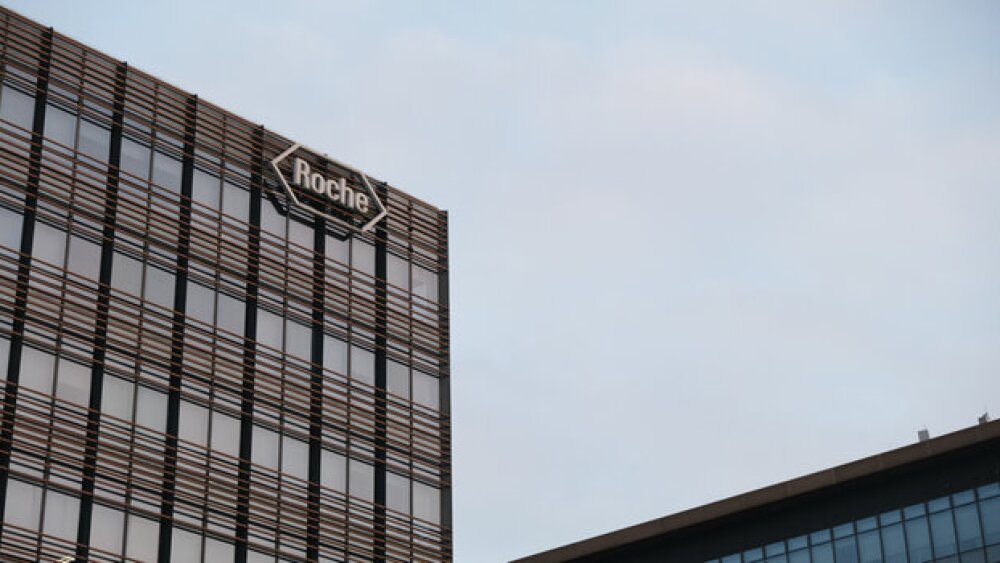Construction is complete on the tallest addition to the Phoenix Biomedical Campus—the 10-story Biomedical Sciences Partnership Building (BSPB) designed by Los Angeles-based CO Architects with Ayers Saint Gross of Tempe, AZ.
Collaboration Encouraged in 10-Story Building Designed to Recall Arizona Desert Geology
PHOENIX: Construction is complete on the tallest addition to the Phoenix Biomedical Campus—the 10-story Biomedical Sciences Partnership Building (BSPB) designed by Los Angeles-based CO Architects with Ayers Saint Gross of Tempe, AZ. Programmed, designed, and constructed in only 27-months, the 245,000-square-foot, $99-million laboratory complex allows University of Arizona research scientists to collaborate with local healthcare providers and private companies to find new medical cures and treatments.
“We will pursue expanded partnerships with industry that we hope will lead to groundbreaking discoveries,” said University of Arizona President Ann Weaver Hart at the building’s dedication ceremony. “This building will allow us to further these efforts, and, ultimately, improve lives.”
Drawing Inspiration From the Desert
BSPB is located to the north of the Health Sciences Education Building (HSEB)—also designed by the same architect and contractor team—on the University of Arizona’s biomedical research campus in downtown Phoenix. BSPB is funded through bonds paid for largely with state-lottery money and built by Phoenix-based DPR/Sundt Construction, a joint venture.
The award-winning HSEB, with learning facilities and amenities shared by the University of Arizona’s College of Medicine and Northern Arizona University’s Allied Health Program opened in 2012. Its distinctive, copper-clad design draws inspiration from the region’s mountains and canyons.
“The architecture of the Biomedical Sciences Partnership Building is similar to that of the Health Sciences Education Building in suggesting Southwestern geology through its horizontal striations and chiseled exterior,” says CO Design Principal Paul Zajfen, FAIA. “We wanted to introduce consistency and a strong sense of identity in this part of the campus by relating the two buildings.”
Similar to the education building, the newer biosciences structure is clad in folded copper panels, but its exterior, through pronounced setbacks and projections, presents a different physical interpretation of the tall, cleft, desert rock formations. Because the same team had conducted extensive studies, computer modeling, and mockups for the copper skin on HSEB, they were able to quickly apply their knowledge to the new building. “The process was easier this time by taking advantage of newer software,” says Arnold Swanborn, AIA, LEED AP, Associate Principal at CO Architects. “Grasshopper and Rhino allowed us to design the undulating copper panels’ complex geometry in record time.”
Cantilevered floors extending increasingly outward at the top of the building shade the lower levels. Windows are mostly limited to the north and south sides of the building to control daylight and conserve energy. The space between the paired campus structures is richly landscaped with native desert plantings, such as a canyon floor would be, to create a shady courtyard. A bridge at the third floor connects the two related buildings.
Encouraging Scientific Collegiality
BSPB is organized to encourage collegiality, collaboration, and customization. “This building was programmed and planned before we knew who any of the occupants were, so we designed a general framework of labs, support spaces, and offices,” says Andrew Labov, FAIA, Principal at CO Architects. “The intent was to create an adaptable plan and utility distribution backbone that will be easy to modify when people eventually occupy the spaces and use them for different types of research.”
Open offices at the north perimeter take advantage of daylight and views, and are visually connected to the labs currently supporting neurological, cardiovascular, cancer, genomic, and nano-bioscience research. Highly flexible lab support spaces were designed as “wet garages” and are arranged next to the windows on the south side. Mechanical equipment is housed on the windowless east and west ends, rather than on the rooftop, protecting the occupants from the intense Phoenix sun.
At the northwest corner of the building, researchers and industry representatives meet on laboratory floors to exchange ideas in glass-enclosed two-story spaces designed with meeting rooms, lounges, and kitchenettes. A sheltering entrance porch on west side of the building faces the central campus green. Extending northward from the portion of the building containing lobbies, café, library, and meeting spaces—nicknamed “The Mixing Bar”—the entrance forms a sunshaded gathering space similar to an outside lobby. A linear gallery connects the lobby to the courtyard, and acts as a pre-function space for a multi-purpose meeting center able to accommodate groups ranging from 50 to 200 persons.
The LEED Silver-certified building institutes various sustainable features, such as copper paneling made of 95% recycled materials, passive orientation, cascade air supply system, chilled beams in labs and open offices, and LED lighting throughout the facility.
About CO Architects
CO Architects is renowned for its extensive portfolio of large and complex academic, laboratory, institutional, civic and healthcare projects, including facility evaluation, renovations, new structures, and comprehensive planning. The firm has designed major “benchmark” and award-winning facilities for clients that include the University systems of Arizona, California (eight campuses), Texas, Virginia, Washington, and Wisconsin, Palomar Health, Natural History Museum of Los Angeles County, BioMed Realty Trust, and Kaiser-Permanente. CO Architects is sought after for functional, green, and graceful solutions for the wide range of academic, civic, and institutional needs. Project team: Paul Zajfen, FAIA, RIBA, design principal; Jon Kanda, FAIA, principal in charge; Andrew Labov, FAIA, LEED AP, principal/science & technology director; Tony Moretti, FAIA, principal/technical principal; Arnold Swanborn, AIA, LEED AP, associate principal/senior design architect; Jennifer Swedell, AIA, LEED AP BD+C, associate principal/laboratory planner; Antoinette Bunkley, Assoc. AIA, LEED GA, associate/project manager; Don Kim AIA, senior associate/project architect; Kevin Kavanagh, AIA, senior associate/building envelope technical architect; Crystal Martinez, CID, IIDA, LEED AP ID+C, senior associate/interior designer; Stephanie Horstman NCIDQ, associate/interior designer; Stephen Sedalis, designer; Chris Kaiser, designer; Joqua Jordan, project assistant.
About Ayers Saint Gross
Founded in 1915, Ayers Saint Gross is an internationally recognized planning and architectural design firm with offices in Baltimore, MD, Tempe, AZ, and Washington, DC. With 130 professionals, the firm is organized into several cross-disciplinary studios specializing in the design of academic facilities, student life facilities, campus plans, landscape architecture, environmental signage, graphic design, and 3-D visualization. The firm’s body of work includes 500 projects for more than 100 colleges, universities, and learning and research institutions around the world ranging in size from 1,200 to more than 100,000 students. Project team: Jack Black, AIA, LEED AP BD+C, principal; Eric Zobrist, AIA, LEED AP BD+C, project architect; Michelle Kollmann, LEED AP BD+C, designer, interiors; Elizabeth McLean, AIA, NCARB, technical production; Justin Dahl-James, RA, LEED GA, technical production.
About DPR Construction/Sundt Construction, Inc., Joint Venture
The DPR Construction/Sundt Construction, Inc., Joint Venture (DPR/Sundt) is a seasoned, award-winning Life Science Building Team. The DPR/Sundt team has a proven track record for uniting each company’s individual ideas and experiences to create streamlined processes, and develop new methods of constructing state-of-the art, LEED-certified life science, laboratory, healthcare, and educational projects. With more than 127 LEED Accredited Professionals on staff in the Southwest alone, the joint venture is committed to sustainability. Together DPR/Sundt built The Biodesign Institute at Arizona State University, Buildings A and B, each achieving LEED-NC New Construction Certification. Building A achieved Gold, while Building B became the first Platinum-certified building in the state of Arizona. Project team: Peter Berg, LEED AP, DBIA, design builder project director, DPR; Djuro Rosic, LEED AP, general superintendent, DPR; Derek Kirkland, LEED AP, preconstruction director, DPR; Greg McDermott, superintendent, DPR; Ivan Christiansen, MEP manager, DPR; Cassie Robertson, LEED AP, estimator, DPR; Corey Munoz, MEP preconstruction estimator, DPR; Janet Howe, safety director, DPR; Gil Salazar, safety manager, DPR; Justin Schmidt, LEED AP, BIM manager, DPR; Erika Byse, LEED AP, scheduling manager, DPR; Wayne Einbinder, PE, LEED AP, DBIA, senior project director, Sundt; Kent Bosworth, LEED AP, DBIA, project director, Sundt; Terry Abair, preconstruction manager, Sundt; Kent Gabrielson, senior project engineer, Sundt; Cassandra Halverson, LEED AP, field engineer, Sundt; Michelle Pomeroy, project administrator, Sundt; Kira Bruun, intern, Sundt; Stewart Grauer, CPC, senior preconstruction project manager, Sundt; Raymond Baker, DBIA, senior estimator, Sundt.
About Phoenix Biomedical Campus
The 28-acre campus in downtown Phoenix was established through an unprecedented statewide collaboration of the Arizona Board of Regents, City of Phoenix, Translational Genomics Research Institute (TGen), and Phoenix-area teaching hospitals. The property, donated by the City of Phoenix, was the site of TGen and Phoenix Union High School. Following extensive renovations, the buildings became home to the University of Arizona’s College of Medicine-Phoenix, which admitted its first class of medical students in 2007.
Project Team:
Executive and Design Architect (includes Master Planning, Programming, Laboratory Planning, Architecture, and Interior Design): CO Architects
Associate Architect: Ayers Saint Gross
Contractor: DPR Construction/Sundt Construction, Inc., Joint Venture
MEP Engineer: AEI Engineers
Structural Engineer: John A. Martin & Associates
Landscape Architect: Colwell Shelor
Civil Engineer: Dibble Engineering
Lighting Designer: Kaplan Gehring McCarroll Lighting
Fire Protection/Code Consultant: Jensen Hughes
Loading/Vertical Transportation Consultant: Lerch Bates
Information Technology/Audiovisual Technology: JBA Consulting Engineers
Cost: The Capital Projects Group
Acoustics/Vibration: Novus Environmental
Energy and Environmental Design: Atelier Ten
Photographer: Bill Timmerman




